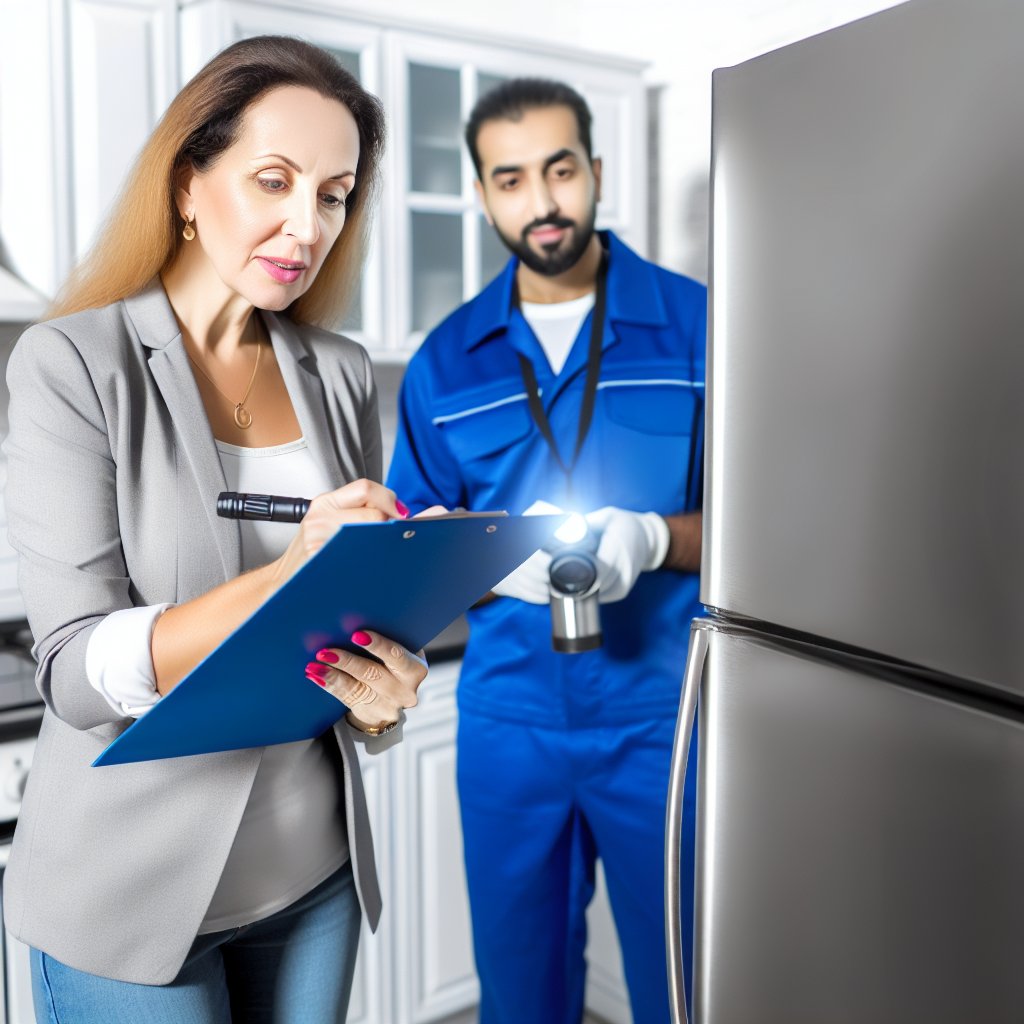Introduction to Home Inspections and the Importance of Appliance Functionality Verification
Home inspections play a crucial role in the buying process.
They provide insight into the overall condition of a property.
Furthermore, they ensure that appliances function correctly.
Many buyers often overlook appliance checks.
However, verifying functionality can prevent future issues.
This checklist will guide you through essential appliance inspections.
By ensuring all appliances are working, you protect your investment.
Why Appliance Functionality Matters
Appliances are integral parts of a home.
They contribute significantly to daily living convenience.
Inoperative appliances can lead to costly repairs.
Moreover, they can result in unsafe living conditions.
Thus, functionality checks are non-negotiable during inspections.
Common Appliances to Inspect
Before finalizing your inspection, review all appliances.
- Refrigerator
- Oven and Range
- Dishwasher
- Washing Machine
- Dryer
Inspecting these appliances helps reveal potential issues.
Steps for Verifying Appliance Functionality
Begin by checking power connections for each appliance.
Next, ensure that all controls and features operate smoothly.
Additionally, listen for unusual noises during operation.
Finally, check for leaks or signs of wear.
Document each inspection to identify specific issues.
Follow-Up Actions for Non-Functional Appliances
If any appliance fails the functionality test, take action.
- Consult a professional technician for repairs.
- Request the seller to address any issues.
- Consider negotiating appliance replacements or credits.
Taking proactive steps can save you stress and money.
Ultimately, ensuring appliances work correctly is vital to a successful home inspection.
Essential Appliances to Include in the Inspection Checklist
Kitchen Appliances
Inspect the refrigerator for temperature consistency.
Ensure the freezer maintains the correct freezing temperature.
Examine the oven for proper heating and functioning controls.
Check the stovetop burners for even flame and ignition.
Review the dishwasher for effective cleaning and water drainage.
Laundry Appliances
Inspect the washer for proper spin cycle and water drainage.
Check the dryer for sufficient heat and tumbling action.
Ensure venting systems are clean and unobstructed.
Heating and Cooling Appliances
Examine the furnace for safe operation and airflow.
Inspect the air conditioning unit for efficient cooling and maintenance needs.
Ensure ductwork is sealed and free of leaks.
Water Heating Appliances
Inspect the water heater for leaks and proper temperature settings.
Check for signs of rust or corrosion.
Examine the pressure relief valve for functionality.
Miscellaneous Appliances
Check smoke detectors for operational batteries and alerts.
Inspect thermostats for accurate temperature readings.
Ensure exhaust fans in bathrooms and kitchens work correctly.
Step-by-Step Process for Testing Major Appliances
Testing Refrigerators
Start by checking the temperature settings on the refrigerator and freezer sections.
Verify that the refrigerator maintains a temperature between 35°F and 38°F.
Inspect the door seals for any cracks or gaps that might affect performance.
Additionally, listen for any unusual noises while the unit is operating.
Check the ice maker for functionality, if applicable.
Lastly, assess the condensation and drainage system for any clogs.
Testing Ovens
Preheat the oven to the required temperature to begin testing.
Use an oven thermometer to ensure it accurately reaches the set temperature.
Inspect the oven’s heating elements for any visible damage or rust.
Examine the door seal to confirm a tight fit that prevents heat loss.
Check the self-cleaning feature by initiating a cleaning cycle.
Finally, test the broiler function and ensure it operates correctly.
Testing Dishwashers
Start by reviewing the dishwasher’s settings and cycles for proper configuration.
Run a short cycle without dishes to check for leaks inside and underneath.
Inspect the spray arms to confirm they are free of obstructions.
Next, confirm the detergent dispenser opens correctly during the wash cycle.
Listen for any unusual sounds during operation that may indicate issues.
Lastly, check the draining function by ensuring all water is properly expelled after the cycle.
Explore Further: Key Factors For A Thorough Home Inspection Checklist To Protect Buyers
Checking HVAC Systems
Heating Functionality Assessment
Begin by checking the thermostat settings.
Verify that the thermostat is operational and set to the heating mode.
Turn on the heating system and listen for sounds.
Check for any unusual noises during operation.
Once the system starts, feel the air coming from the vents.
Ensure that warm air flows freely from all open vents.
Monitor the heating system to see how quickly it warms your space.
A properly functioning heater should warm the space efficiently.
Cooling Functionality Assessment
Next, assess the cooling system, starting with the thermostat.
Set the thermostat to the cooling mode and lower the temperature.
Listen for the air conditioner to kick on.
Check the airflow from the vents once it starts.
The air should feel cool and refreshing.
Inspect the outdoor unit for any obstructions.
Remove any debris that may block airflow around the unit.
Ensure the air conditioner runs without any loud or unusual noises.
Regular Maintenance Checks
Conduct regular maintenance for optimal operation.
This includes changing filters every few months.
Clean the air ducts to enhance airflow efficiency.
Schedule professional inspections annually to maintain system health.
Check refrigerant levels in the cooling system regularly.
Address any leaks or issues promptly to prevent costly repairs.
Stay proactive with maintenance to extend equipment lifespan.
Discover More: Home Inspection Checklist For Post-Inspection Repairs And Renovations
Evaluating Washing Machines and Dryers
Operational Tests
Begin the inspection by checking the power supply.
Ensure the washing machine is plugged in and the outlet is functional.
Next, run a short wash cycle.
Observe how the machine fills with water.
Listen for unusual noises during operation.
At this point, check the drain functionality.
Ensure the water drains completely after the wash cycle ends.
Inspect the spin cycle to confirm efficiency.
Additionally, check for any leaks around the hoses.
Common Issues
Many washing machines face drainage problems.
Clogs in the drainage hose frequently cause this issue.
Another common problem is inconsistent spinning.
This often results from an overloaded washer.
Furthermore, some machines may display error codes.
Check the user manual for specific troubleshooting steps.
Dryers can also experience common malfunctions.
First, verify that the dryer heats properly.
A lack of heat may indicate a blown thermal fuse.
Additionally, check for proper airflow.
Blocked vents can hinder efficient drying.
Routine Maintenance for Longevity
Regular cleaning can prevent appliance issues.
Check and clean the lint trap in the dryer after each use.
For washing machines, leave the door open to prevent mold.
Periodically, run a cleaning cycle with vinegar.
This helps eliminate odors and residue buildup.
Lastly, schedule professional servicing as needed.
This practice can enhance the lifespan of your appliances.
Find Out More: Top Mistakes First-Time Homebuyers Should Avoid When Purchasing A Home

Electrical Safety Checks
Inspecting Appliance Plugs
Start by examining each appliance plug for damage.
Look for frayed wires or cracks in the casing.
If you notice any issues, do not use the appliance.
Check that the plug fits securely in the outlet.
A loose connection can lead to electrical arcing.
Evaluating Outlets
Next, inspect the electrical outlets in your home.
Ensure there are no signs of burning or discoloration.
These can indicate serious electrical problems.
Check that all outlets accept plugs without force.
If a plug is difficult to insert, replace the outlet.
Using Ground Fault Circuit Interrupters
Verify that ground fault circuit interrupter (GFCI) outlets function correctly.
Press the “Test” button on the outlet to check its efficacy.
The reset button should pop out to indicate functioning status.
If it does not, this outlet needs servicing or replacement.
Reviewing Extension Cords
Inspect extension cords for signs of wear and tear.
Avoid using damaged cords as they are fire hazards.
Ensure cords are not running under rugs or furniture.
These scenarios can cause overheating.
Always use extension cords rated for the appliance’s power needs.
Confirming Circuit Breaker Functionality
Finally, assess the circuit breaker panel in your home.
Check for tripped breakers or blown fuses.
Reset any tripped breakers if safe to do so.
Consult an electrician for frequent issues or concerns.
Discover More: Understanding Closing Costs and Their Role in Homebuying
Identifying Red Flags During Appliance Functionality Checks
Visual Inspection of Appliances
Start by visually inspecting the appliances in the home.
Look for any signs of wear, damage, or rust.
Check for frayed wires or loose connections as well.
Any visible damage can indicate deeper issues.
Make a note of appliances that appear older or poorly maintained.
Testing Appliance Operation
Next, test the operation of each appliance systematically.
For each appliance, turn it on and observe its performance.
Listen for unusual noises during operation.
Check for abnormal vibrations that might indicate a problem.
Ensure that all settings operate correctly and respond as expected.
Evaluating Safety Features
It’s crucial to verify the safety features of appliances.
Test any automatic shutoff systems if applicable.
Make sure smoke detectors and carbon monoxide alarms are functional.
Confirm that all appliances have proper ventilation systems in place.
Look for safety labels and certifications on each appliance.
Check for Energy Efficiency
Assess the energy efficiency of the appliances in the home.
Look for Energy Star ratings or other efficiency certifications.
Consider the age of the appliance, as older models may be less efficient.
Ask about past energy bills, as high costs can signal inefficiency.
Consult Documentation and Service History
Review any documentation related to the appliances.
Check for user manuals that provide operational guidelines.
Request service history records to see past issues and repairs.
Any repeated repairs on the same appliance could indicate a red flag.
Professional Inspection Recommendations
If any red flags arise during your checks, consider professional help.
Home inspectors bring expertise in identifying hidden issues.
They can provide detailed reports and recommendations.
Investing in a professional inspection offers peace of mind.
Documenting Findings and Recommendations for Repairs or Replacements
Importance of Thorough Documentation
Thorough documentation ensures clarity during the inspection process.
It provides a detailed account of each appliance’s functionality.
Furthermore, it highlights any potential issues for future reference.
Creating Inspection Reports
An organized inspection report is essential for homeowners.
It should include a list of appliances being inspected.
Next, record findings about each appliance’s performance.
Include observations on their condition and any visible issues.
Clearly indicate whether each appliance is functioning properly.
Additionally, note any unusual noises or malfunctions.
Recommendations for Repairs
Each documented issue should include a recommendation for repair.
For minor issues, suggest simple maintenance tasks.
For major problems, recommend contacting a professional technician.
Clearly outline the steps homeowners should take for repairs.
Replacements Considerations
Sometimes, appliances may need complete replacement.
Factors like age and efficiency can influence this decision.
Provide homeowners with information about replacement options.
Focus on energy-efficient models to reduce future costs.
Following Up After Inspection
A follow-up after the inspection enhances trust with homeowners.
Encourage them to reach out with any questions about findings.
Consider providing additional resources for appliance maintenance.
Support them in tracking the progress of repairs or replacements.
Additional Resources
CHAPTER 5: PROPERTY REQUIREMENTS
Everything you need to know about due diligence in real estate




